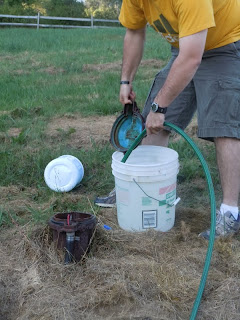On July 25th we had an inspection agency at the cabin testing the septic, water flow, and water quality. A week later on August 2nd we found out the well failed the water quality test. We were fortunate because the results were negative for e-coli however, the water did fail for coliform.
The house has been empty for almost a year so the well has not been in use causing bacteria to grow in the well and water. We were informed that the well would need to be chlorinated and then retested. So, the week of August 2nd we began the process of chlorinating the well.
The theory was simple: dump bleach down the well to kill the bacteria.
We completed our first attempt on August 2nd with very discouraging results. Andrew poured 1 gallon of bleach down the well. We waited the appropriate amount of time and then started the process of pumping it through the entire system waiting until you can smell bleach at the faucets. However, we never smelt the bleach. After an hour we started the process again per the instructions we were given. Another 1 gallon of bleach was added and after 40 minuets still no smell of bleach. We were beginning to get worried. If this did not work we would have to install a water purification system costing us $2,000.
We came home and began our research online. In the meantime we found of out from Oma, my grandmother, that the well at the cabin is 460 ft deep with 170 feet of well cassing. We were not dealing with a standard well but rather a very deep one. We found different directions and were prepared to begin again the following day. Hoping and praying that our new plan worked.
August 3rd, day 2 of chrolinating the well.
Daddy spraying Buddy Bee with the hose.
Don't worry the water will not hurt him we just cant drink from the well.
Andrew's bleach mixture being poured down the well.
This would be the 4th gallon of bleach.
Sanitizing the well cap in the bleach mixture.
The last bucket of bleach water down the well.
Rinsing the bleach down the sides of the well.
This was one of the major flaws in our original directions. Pouring water down the well with the hose rinses the bleach down the well, the water flowing into the well begins mixing the water in the well, and since you are using a hose connected to the well you begin pumping water from the bottom of the well. And it worked like a charm!
Buddy Bee yelling at Daddy to spray him with the hose.
Now he is REALLY upset!
Buddy Bee got his wish from Daddy!
It's raining on the Buddy Bee.
Helping Daddy with the hose.
Buddy Bee loved the gravel!
He would pick up a piece of gravel, put it in his mouth,
take it back out, and put it on the stone wall.
We let the water cycle for a half hour and then turned on the faucets. Almost immediatly we could smell bleach! YAY! After a few minuets of running all the faucets this is what we got...
Orange water.
This is not a problem. It is a good sign. Colored water means that the bleach is sanitizing the water and killing the bacteria! Plus running the system full force, like we had been, was kicking up sediment at the bottom of the well. Once we smelled bleach at all the faucets we turned off the water and would let the bleach continue to do it's thing overnight. The following day we would flush the whole system, letting the water run full force for several hours.
We rid the system of all the bleach and now are just waiting for the second water quality test.

















No comments:
Post a Comment